The Fool In Tarot: Beginning The Hero's Journey

All things start with an idea and a desire. Before reality, a dream. The seed, then the forest. A beginning and an end. Birth, then death.
The Fool is that first inkling of desire. The first spark of creation. With the Fool, anything and everything is possible. The Fool is limitless potential and endless creativity.
This card is the very beginning of choices. It is that child-like soul, bright-eyed and ready to investigate the world. It is the first opportunity for the divine to take on material form, the moment of conception.
As we progress through the Major Arcana, think of it as the Fool shapeshifting into different forms, trying on different skins of possibilities, facing challenges, and meeting companions and guardians along the way.
The Fool makes mistakes, becomes disempowered, faces tragedy, and in the end, becomes transformed and atoned.
This is the hero’s journey.
The Fool Keywords
- New beginnings
- Prophecy
- Leaps of faith
- Child-like innocence
- Pure potential
- Harmony despite chaos
- Revelry and wildness
- Innovation
- Spiritual ignorance
- Expansion
- Pure state of nature
- Madness
- Overeagerness
- Mania
- Stagnation
- Lack of desire
- Carelessness/insensitivity
- Negligence
- Frenzy
- Rebel without a cause
- Denial
- Extravagance
- Number Zero: all possible expressions and pregnant nothingness
- Zodiac sign: all signs
- Planet: Uranus (modern)
- Element: Air
A Note on Reversals
Some readers don’t use them. However, I’ve included reversed keywords because it can be helpful to use them if you wish. As you grow your knowledge base and do more readings, you’ll get an intuitive feel for which valence the card’s meaning takes on.
Whether reversed or not, each tarot card can contain positive or negative valences and everything in between. In the following sections, I will not be using reversed meanings. Instead, I will refer to card placement as poorly or well-positioned.
In addition to astrological correspondences, unified color and element themes, and figure interactions, well-positioned cards have many other characteristics that gel together and support the card’s overall symbolism.
Poorly positioned tarot cards are discordant, not necessarily “bad” or “negative.” Typically they will have opposing themes such as complimentary colors (i.e., one card has a lot of yellow, and the other has a lot of blue). Or, figures on the card are facing away from one another.It takes time to intuit the valence of a card within a reading.
Ultimately it’s up to your intuition. Do the cards make you feel anxious when they are together or happy? Let your body do the talking.
What does the fool tarot card mean?
The Fool card in the tarot represents new beginnings, spontaneity, and a leap of faith. It can indicate a need to let go of old patterns and limited self-conscious beliefs to embrace new opportunities or possibilities.
If the Fool appears in a reading, the reader should take time to understand its valence. It can be an Uno reverse card if placed poorly. Despite its chaotic nature, it can show a time of taking a risk or making a bold move, despite the uncertainty of the outcome.
In any case, the Fool tarot card is a reminder to let go of the ego to embrace a spiritual perspective based on intuition and trust.The Fool card in the tarot is a journey of spiritual awakening and enlightenment, as represented by the initiation of the hero’s journey. The Fool’s path is about rediscovering inner divinity and the source of all things.
It can be a call to question one’s beliefs and preconceptions and to be open to new experiences and wisdom, particularly with the help of others.
The Fool can also represent the idea of being a beginner and the joy and wonder that comes with that. The Fool card can remind us to approach our journey with an open mind, a sense of wonder, and a willingness to embrace the unknown.
In addition to the qualities above, the Fool card can indicate that you might receive a message soon, someone is playing a trick on you, or it can tell you you are making a reckless choice.
Regarding health and well-being, The Fool relates to the nervous system. If positioned poorly, the Fool can indicate a struggle with anxiety, back pain, nerve issues, or problems with the ankles.
A negative valence of the Fool can also indicate brain fog or issues with the spinal cord. Other issues the Fool can represent are mood swings, hypervigilance, narcissism, and tendencies toward self-destructive behavior.
In a well-placed position, the Fool can be an indication for initiating a new exercise routine, accepting current circumstances as they are if battling with a diagnosis, or changing a course of treatment.
*Please note that you should not rely on tarot cards to make medical decisions.*
If the Fool appears in a reading about money, there will be a dramatic change in the querent’s financial situation.
Often, the poorly placed Fool card is related to gambling gone wrong, dramatic changes tied to hubris, recklessness, or putting trust in someone blindly.
Whenever well placed, the Fool helps overcome redundancy and maintain forward momentum. The Fool does not guarantee success because it is too chaotic. The card reminds you to spend wisely, even if jumping into something with blind faith.
how to rely on yourself for interpretation
You don’t have to rely on pages like mine to find your interpretation of the cards. All it takes is a bit of learning, a dash of curiosity, and an easy way to break out different pieces of a card into digestible parts.
It can be as easy as picking one symbol and going with it. One deep dive will surprise you with the plethora of symbolism you’ll find.
As we investigate the Fool’s symbolism, think about how I’m looking at significant themes on the card, then fracturing those themes into smaller pieces.
Each small piece represents an aspect of the Fool, like putting together a puzzle. That piece shows you a fraction of what the Fool means but still contains the card’s essential meaning and depth.
Even if you only master a piece of the puzzle, you can use that piece to extrapolate the greater whole. Remember, the tarot is a microcosmic portal of human experience.
Historical context
The Fool tarot card is linked to a long tradition of civilized man’s contemplation of wild men and green men.
Through an examination of mythology across several centuries, we can find several vital themes: madness, unrestrained revelry, sacred knowledge, extravagance, negligence, and a pure state of nature informing the meaning of the Fool as we know it today.
Surprisingly, the Fool’s ancient origins also point to other abilities, such as prophecy, poetry, and music.
As we uncover all the secrets in the Fool tarot card, we can contemplate other themes like new beginnings, spiritual ignorance, and child-like innocence in a new light.
Tarot card games
The tarot originated in the Early Renaissance as a gambling game called Tarocchi. The Major Arcana was the Trumps, or high-ranking, winning cards in Tarocchi.
Of the Trumps, the Fool was the most variable, with its rules changing from region to region. Some variants of the Fool considered it the lowest Trump, others the highest.
Commonly the Fool was the Excuse card, the most valuable of the cards, allowing a player to bend the rules of the game.
Whether the highest or the lowest valued card, the Fool stood out as a wild card, always independent and mysterious.
The Fool has mostly stayed the same through the centuries in its pictorial depiction: frequently illustrated as a beggar or a madman wearing feathers, loincloths, or the clothes of a jester and carrying a staff.
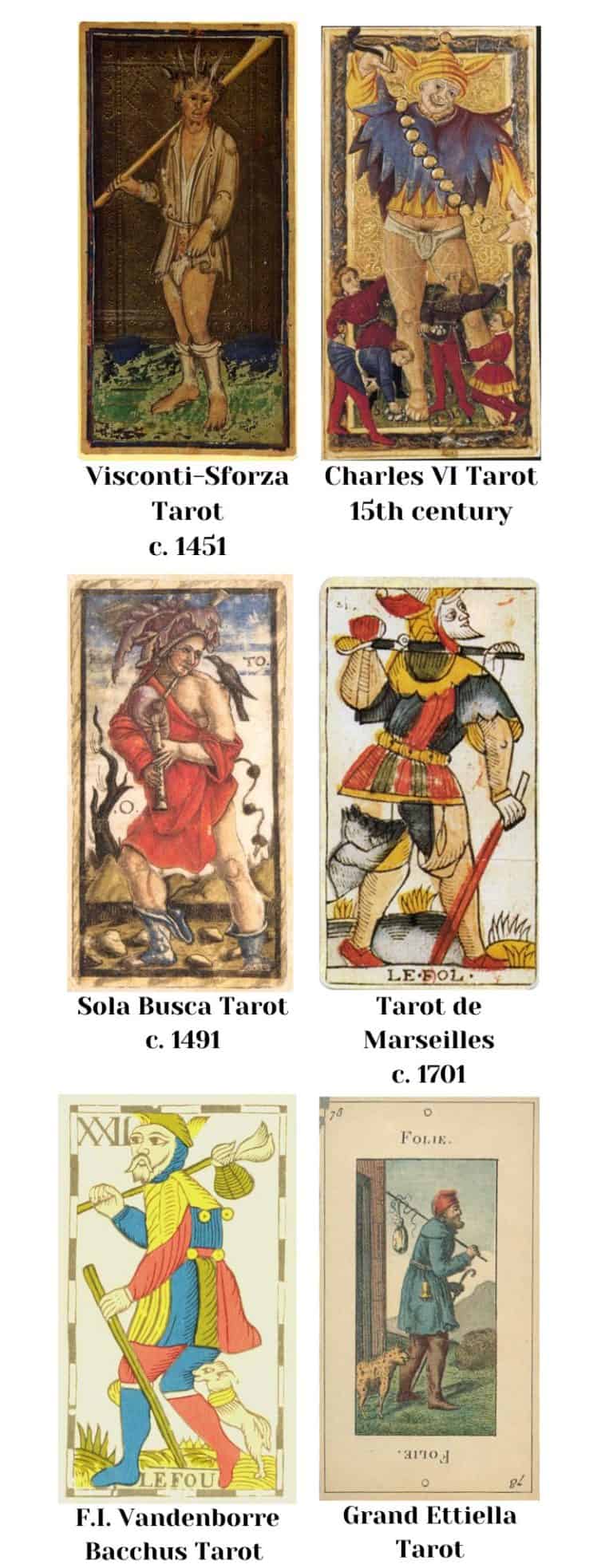
Even the Rider Waite Smith tarot deck’s depiction of the Fool shows it as seemingly careless and eccentrically dressed.
These primal visions of the Fool card allude to the mythical Woodwose or wild-man whose storied mythology offers insight into his character.
The Wild Man
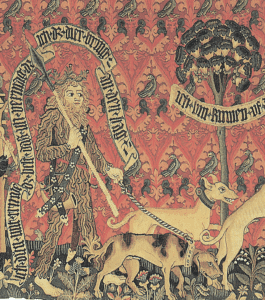
In Renaissance art, the wild man portrays a hairy, ferocious, and uncivilized man living in the woods, dancing under the light of the moon, and partaking in the wild dance and revelry often associated with the pagans.
The wild man has existed for millennia. Covered in fur from head to toe, wielding a giant club or staff, and living like a beast, this creature of yore has appeared in art as early as the ancient Greeks and even in modern stories of Big Foot and Sasquatch.
We see vestiges of the wild man painted on murals in cathedrals and on heraldry, often alongside the even more mysterious Green Man. Likely the wild man represented conquering beastly tendencies, a trophy of civilized society, and evidence of man without God.
Yet, the origins of this mysterious creature likely go back further into pagan traditions. Wild men known as lutins lived in the Pyrenees mountains, dancing in the firelight to summon demons for fertility rituals.
They would burn effigies and carouse untamed, wearing nothing but grass, leaves, and moss to appease the spirits of the forest for bountiful harvests.
Despite the persecution of pagan beliefs in a Christian-dominated world, certain practices continued, albeit modified. A custom in medieval Europe known as charivari closely resembles pagan superstitions and rituals.Villagers would perform charivari during harvest or planting seasons. Screaming, banging on pots and pans, dancing maniacally, loud off-key music, and effigy burning was commonplace during such parades.
Alternately, the charivari would denounce the sins of a community member, or publicly humiliate unsavory characters, harkening this practice back to pagan traditions such as the Bulgarian kukeri who performed wild man rituals to scare away evil spirits.
The Epic of Gilgamesh (2nd Millenium BC)
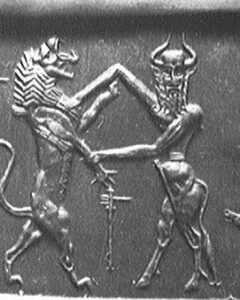
This image of half man half beast takes us back to the ancient Akkadian legends from The Epic of Gilgamesh. A man named Enkidu, created by the goddess Aruru to stop Gilgamesh, King of Uruk, from abusing his people.
First created as a savage half man, half bull, Enkidu was the personification of the force of nature: wild and untamed.
Enkidu was domesticated by a sacred prostitute, eventually becoming King Gilgamesh’s best friend, warrior, and moral guide.
The Epic of Gilgamesh marks Enkidu’s name with a dingir , a cuneiform symbol for the Divine, or an ideogram that means “sky.”
Enkidu’s adventures with Gilgamesh bring the wild man closer to civilization: he becomes more and more refined until he renounces his beastly origins entirely.
The Green Man
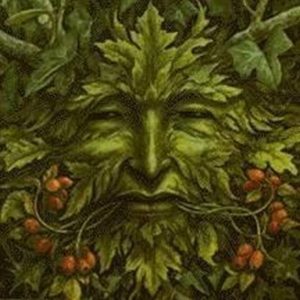
In Southern Germany, a ritual called Pfingstl was the celebrated welcome of spring wherein a Maypole was erected, and a young man dressed in vines, moss, branches, and leaves was brought from the woods under fanfare and laughter.
His face was covered with green branches and tree bark, and the village folk made a game of guessing who was hidden under the disguise. Like Enkidu’s evolution into a civilized man, this ritual symbolized taming the wilds.
In England, the celebration of May Day was marked by Jack o’ the Green, a precession filled with music, dance, cascading flowers, and a central figure wearing a human-sized conical wicker covered in vines and leaves.
The celebration of Spring with the iconic imagery of the Green Man is old, dating back to the Ancient Greek god Pan who ruled over the wild lands, music, impromptu celebration, and fertility.
Pan taught the god Apollo the gift of prophecy. Prophetic visions are linked to religious ecstasy resulting from manic celebratory worship or entheogens in the popular libation, kykeon.
These rituals and others served to herald a season of renewal and new growth – the Spring season and promise of fertile lands. Spring is the beginning of a new cycle of seasons represented by Aries, the first sign of the zodiac.
Synthesizing Historical Context
Just as Spring launches new growth, we can also think of the Fool as one of the first divine emanations of God, or cosmic force, to begin to experience the life cycle on Earth – a process of the soul from spiritual ignorance back to manifest insight.
The common theme here is death and rebirth, signaling that the Fool is on the threshold of this imminent, eternal cycle.
Prophecy, revelry, excitatory states of joy, and transformational visions are known by the god Pan. The rituals practiced in Wild Man, Green Man, and Greek Mysteries allude to the Fool’s capacity of limitless potential and its function as the lightning bolt of desire to take form.
When all things possible lie before a dreamer, it’s like a sandbox game. Anything can be created; any form can be taken. This is the Fool’s capability of turning joyous revelation and lightening insight into shape.
Simultaneously this power of creation, when done under ignorance and without pure intention, can turn into madness, carelessness, and panic. Like a trickster god whose abilities match that of the creator, drunk on power, messing with human minds, and wreaking havoc for the fun of it.
Ultimately, the Fool is a wild card. Its messages can appear volatile and chaotically neutral. The Fool is a divine contradiction: boldness, recklessness, ignorance, and innate wisdom. Yet it is also crucial to initiating the path to enlightenment.
Finally, the Fool offers a choice to dive deeper, launch yourself into new endeavors, expand your inner light, and keep following that yellow brick road.
Other Correspondences in the Fool Tarot Card
When looking at a card, every single design choice counts. Tarot was carefully crafted to include breadcrumbs of esoteric history and symbolism.
Therefore, investigating any one symbol of the card will bring you a wealth of information to help you learn the card. There are 6 categories of symbols that you can look at:
- Astrological correspondences
- Colors
- Objects (buildings, tools clothes, etc.)
- Cultural or religious symbols
- Hermetic Qabalah
- Persistent symbols within a suit (water, pyramids, nature, etc)
- Figures (people, the directions they face, whether they are active or inactive)
We’ve already covered persistent symbols and figures through our historical exploration above. The remaining correspondences have the same rich meaning. They will all contribute to the Fool’s character and representation in unique and blending ways.
All the cards are assigned at least one astrological correspondence: a zodiac sign, a planet, an element, or both.
Astrology makes itself distinct between two systems: modern and traditional. Modern astrology includes the outer planets (Uranus, Neptune, and Pluto), whereas traditional astrology excludes them.
The classic Rider-Waite Smith and Thoth decks use traditional astrology, however, we can be relatively loose in our interpretations to include the modern system as well.
With the modern system, The Fool tarot card is associated with the planet Uranus and the element Air.
Uranus

Astrologically, Uranus is associated with rebellion, destabilization, breakthroughs, rapid change, and pushing past limitations. It’s the mad scientist, the technology guru, and limitlessness.
Uranus is also associated with progress, enlightenment, novelty, and chaos. In its lower octave, Uranus can be a rebel without a cause and bring turmoil in otherwise stable situations.
As the higher octave of the brainy planet Mercury, Uranus holds power over commerce, communication, global networks, and social change.
Using its adept ability to blend intuition with ingenuity, Uranus can be a strong energy to uncover universal secrets and truths.
Uranus is named after the Ancient Greek god of the sky, Ouranos. Ouranos was one of the first deities to appear after the void and fathered the first Titans.
A trailblazer in mythology and astrology, Uranus lends its qualities to The Fool aptly.
Similarly to the planet, The Fool tarot card is the harbinger of change and new ways of thinking. As a spritely character, the Fool is a force of nature with a will as strong as steel.
Nothing and no one will get in the way of the Fool’s burning desire to launch into new activities and blaze a trail through the unknown, uncovering all the juicy little secrets along the way, calling down the lightening of insight.
Just as Ouranos is one of the first deities to appear after the void, so too is the Fool: the first manifestation of the divine.
On the same token, the Fool can possess Uranus’s chaotic qualities such that the bedlam ensuing reckless abandon becomes destructive and thoughtless.
The Fool tarot craves novelty and excitement to the point where each blazing trail becomes an abandoned plaything, left as dust to the wind.
Essential Element: Air
More capricious than fire, the air is the element of our vital life force, the breath, and the heart chakra. From a rampaging tornado to a light summer breeze, air brings all the nutrients, precipitation, and other weather patterns that change the face of our planet daily.
Anahata Chakra
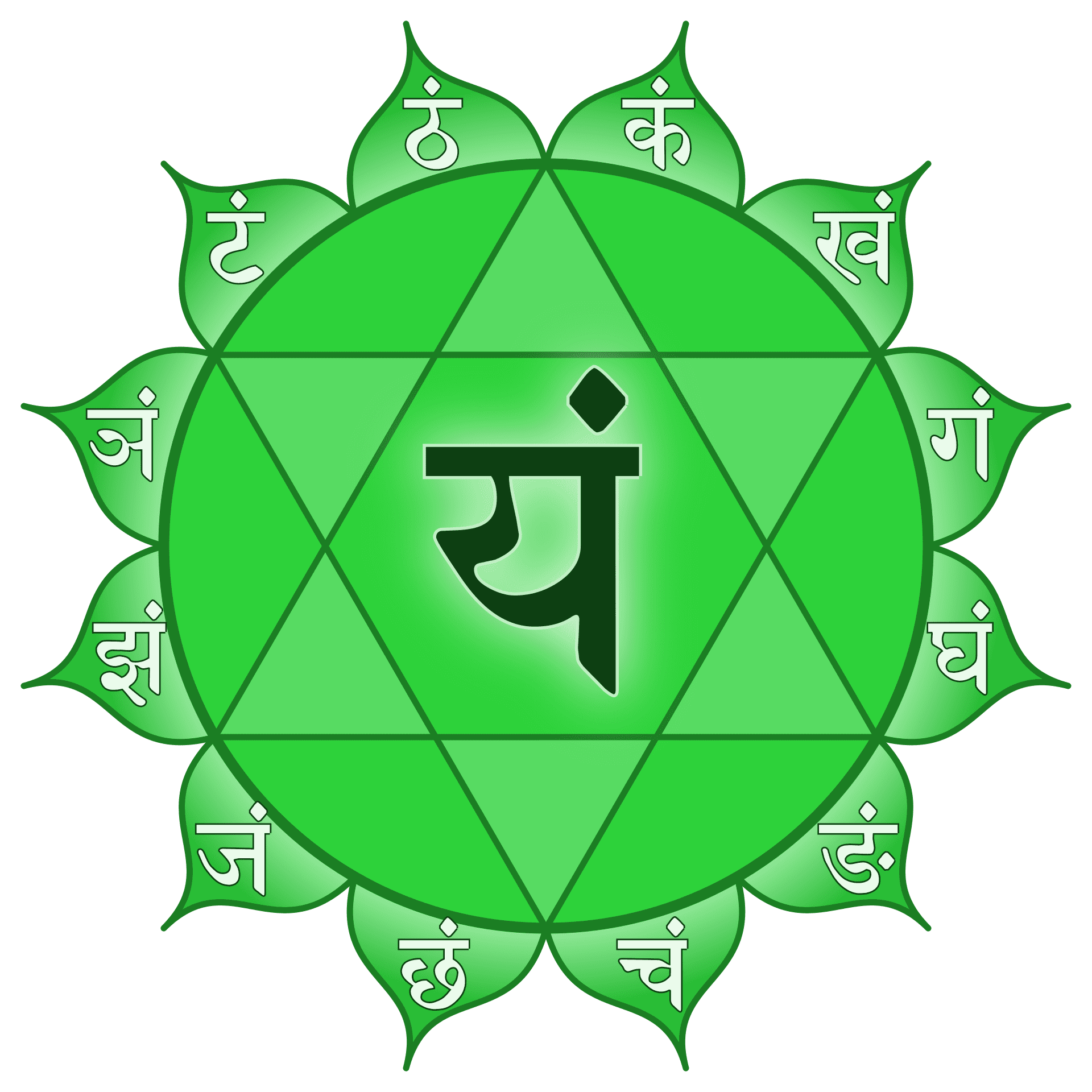
In Sanskrit, Anahata means infinite, boundless, unhurt, unbeaten, and unstuck. Anahata is the heart chakra.
Anahata dwells in the realm of air because its shakti is best accessed in the state of detachment. It is a state of openness and expansion, which can then be filled with love and gratitude.
This chakra is also considered the seat of the soul, where all vitality converges to be redistributed with the breath.
Anahata is about cooperation, integration, and bridging the energies between the lower and upper chakras.
The twelve petals are inscribed with Sanskrit letters defining the divine streams of consciousness which permeate and innervate the chakra.
The petals also correspond with spiritual development elements related to the Fool tarot card.
Thoughtlessness, desire, hope, vanity, fondness, effort, and other subconscious tendencies associated with the Fool are also Anahata chakra manifesting as spiritual ignorance.
Therefore, we can extrapolate that the Fool, although carrying the secrets of the cosmos, is naive to the machinations of the material world and remains ignorant of his development.
Colors, especially in the Rider-Waite Smith deck, are chosen for their correspondence to emotions, impressions on the querent, and consistency across cards.
Typical color correspondences can vary cross-culturally. Even if the meanings differ between cultures, I consider every correspondence relevant to the more remarkable, coherent picture of what the color represents.
This series focuses on the primary colors depicted in the Rider-Waite Smith deck. You can think of shades and different values of each primary color as a diluted or concentrated degree of that color correspondence.
We can get an impression or mental picture of what the color means by using keyword correspondences. When you see that color in other cards, let your subconscious association with that color come through. More likely than not, it matches up to common color meanings.
Color Keywords for the Fool Tarot
- Yellow
- The Sun, higher consciousness, joy, resurrection, paralyzation, air element, spiritual growth, enlightenment, clarity, divine insight, solar plexus/Manipura chakra, increased understanding, sacred masculine, optimism, toxicity, madness, self-empowerment, persuasion
- White
- Purity, creativity, crown/Sahasrara chakra, psychic abilities, soothing, transformation, truth, consecration, lightening (electric), summoning, burning fires of purification, cleansing, illumination
- Orange
- Creativity, self-expression, emotional balance, adaptability, sensuality, veil between worlds, anxiety, memory, warrior, mercy, prophecy, music, poetry, nourishment, insight, energy, transformation, abrasive, crass, safety
- Light blue
- Restful sleep, calm, lethargy, heaven, the sea, divine guidance, unconscious mind, throat/Vishuddha chakra, Neptune, illusions, astral projection, cycle of life, Yahweh, Ankh, power of the mind, resourcefulness, serenity, infinity, intangibility
- Light green
- Fresh growth, Spring, health, fertility, forward movement, bad luck, pregnancy, gambling, stagnation, healing, restoration, envy, jealousy, heart/Anahata chakra, the afterlife, celebration, ignorance, endurance, power
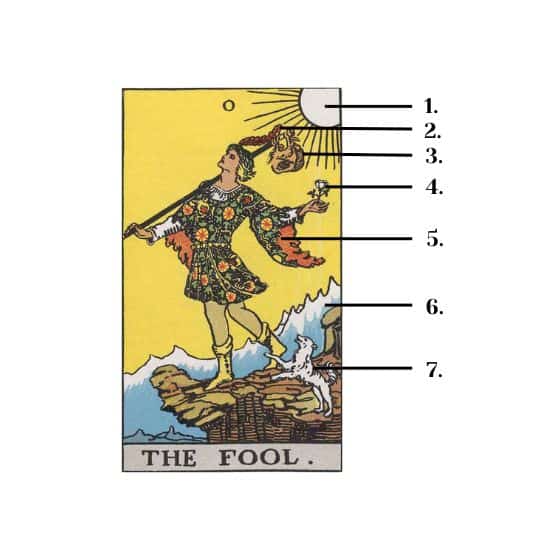
1. Sun
The Sun is a powerful symbol of birth, life, and stability. Not only does the Sun provide nourishment for plants, but it also sustains Earth’s temperature and keeps all the planets in the solar system in orbit.
Ancient humans observed the sun’s passage from the sky to the horizon and wondered, where did it go? Many tales cross-culturally imagine the Sun crossing the boundaries between realms, passing through the underworld to rise again.
In Egyptian mythology, Ra, the God of the sun, would journey to the underworld on his sun boat, Mesektet, reinforcing his role in rebirth and renewal when he completed his journey with the rising sun.
Jóhonaaʼéí, The One Who Rules the Day, in Navajo mythology, or how Nanahuatzin of the Aztecs sacrificed himself in the fire to become the Sun.
Transformation, rebirth, and the journey required to attain the shining brilliance of the Sun, whether it is on Earth or within, is critical to the Fool tarot card’s meaning.
2. Feather
The red feather in the Fool’s cap can indicate several things according to the feather’s ritual use and the feather’s color chosen for the deck.
Indigenous American cultures revered feathers as gifts from the sky presented by the bird’s spirit. Each bird’s spirit represented different archetypes. Traditionally, victorious warriors earn the right to wear an Eagle feather, symbolizing bravery and strength.
The Fool’s bag, embroidered with a bird, could be the Egyptian Bennu bird.
3. Bag on a Pole
Interestingly, the etymology of the word “fool” comes from the Latin follis, which translates to “a bag or sack, a large inflated ball, a pair of bellows.
The link between “fool” and “follis” likely evolved from the resemblance between bellows and people who talk overmuch, effectively puffing out their cheeks to express empty words.
A Greek myth emphasizes the intrinsic hubris of one who is full of wind in Homer’s “Odyssey”.When Odysseus was presented with the gift of the four winds in a bag, his sailors opened the bag while Odysseus slept, hoping to find treasure. As a result of their folly, the ship was blown off course.
This kind of recklessness and hubristic tendency is also found in Chaucer’s Canterbury Tales, wherein fools would carry sticks with puffy bags at the end to slap people with.
As ridiculous as it may sound, the Canterbury Tales version of fools relates to the Fool tarot card’s inherent chaotic and child-like disposition.
Despite this, we know that the Fool contains the potentiality of all divine creation, given its Qabalic associations with the tree of life, and the Fool’s correspondence with Uranus.
This version of the Fool is represented in the Thoth tarot, where his bag contains stones engraved with all signs of the zodiac. The relationship of the zodiac corresponds to the evolution of soul.
In evolutionary and Vedic astrology branches, the progression of the signs from Aries to Pisces represents the soul’s accumulation of wisdom and eventual return to the cosmic source.
Essentially, the physical body and gross material reality are battlegrounds for spiritual transformation and evolution. Thus, the bag in the Fool card represents the container of wisdom that the Fool rediscovers on his journey through the Major Arcana.
4. White Rose
White roses are used as offerings for funerary services – a promise of spiritual peace and serenity for the bereaved and the dead. This particular color is also associated with purity, purifications, and regeneration.
Many traditions include the gift of white roses, such as marriage, recent graduates, and baptisms. These act as a send-off for the next step of a new journey.
White is also associated with innocence, and the Fool embodies the wisdom of child-like purity. Everything the Fool tarot card encounters is new, seen from someone who has never experienced anything like materiality.
Relevantly, a story from Greek myth tells us how red roses came to be. The legend tells of Aphrodite’s love for Adonis.
One day, Adonis went into the forest, searching for animals to hunt. Aphrodite warned him to be careful of animals that seemed unafraid.
Despite Aphrodite’s warnings, Adonis came upon a wild boar that eventually killed him. Upon discovering his death, Aphrodite ran after his body, where she accidentally cut herself. Her blood turned a white rose red.
This allegory teaches us several things: do not trust blindly, and heed the warnings of your guides.
The Fool card expresses the same sentiment. Like a child who tries to stick their finger into an electrical socket, the blind faith of someone ignorant may lead to trouble.
5. Dress
The artist of the Rider-Waite Smith deck, Pamela Coleman Smith, was an initiate of the Hermetic Order of the Golden Dawn. This occult group was heavily invested in alchemical teachings in addition to other occult arts and sciences.The ultimate goal of alchemy is called the Rebis – it is the reconciliation of duality into divine singular form. Turning lead to gold was one such attempt at achieving the perfect form of the cosmos.Similarly, the alchemists believed that seemingly opposing forces could be joined together through purification and putrefaction. Spiritual enlightenment, therefore was the union of the divine feminine and the divine masculine.Androgyny, therefore, was revered and idealized symbolically through the Rebis. Sun and moon, male and female, Saturn and Jupiter, Mars and Venus – forces of cosmic duality fused to create the whole.The Fool is frequently depicted in androgyny. With a male’s face and body and a female’s dress, the Fool likely corresponds to these alchemical principles.The 8-pointed stars on the Fool’s dress further emphasize evidence for this correlation to cosmic pairs. Not only is this a reference to the Star tarot card, but the stars also correspond to several religious traditions listed below.
- Noble Eight-fold path (Buddhism)
- Perfecting ethical conduct, mental discipline, and wisdomStar of Lakshmi (Hinduism)
- Eight forms of wealth
- Family, financial, prosperity, transportation, victory, patience, health, and knowledge
- Perfect pairs in duality
- The Ogdoad of Egyptian deities, four male–female pairs, together, create the world through flood, darkness, unboundedness, and invisibility
The Fool’s dress indicates spiritual development and evolution – the beginning of the path toward higher consciousness.
6. Mountains
Mountains are sacred places in many cultures. The Tibetan monks would climb to the peaks and sit in caves for meditation retreats spanning many months of isolation and limited nutrition.
The Amazonian tribes living near the Andes mountains climb to the peaks to push the limits of physical endurance and achieve visions. These rites of passage are essential for those on a healer’s path.
Some people believe that the ancient Lemurians made their refuge in Mount Shasta, living in a complex network of tunnels and caverns to this day.
Mountains result from the movement of massive tectonic plates smashing together giant land masses over incredible amounts of time.
It’s no mystery why mountains fascinate us. They appear cold and uninteresting to the naked eye, yet serve many functions imperative to our survival.
Melting snow from mountain peaks feed streams and fertilizes the valleys below. By sheer force of size, mountains redirect air currents and create a variety of ecosystems.
As such, mountains represent the principles of ancient wisdom, feeding the fertile planes of mental imagery and proffering transformation through rites of endurance and solitude.Similarly, the Fool’s journey takes on this flavor of trial and tribulation, questing for the vision that takes the Fool to the next stage of development.
7. Dog
Dogs throughout history feature heavily in mythology as companions in life and death.
In South America, the ancient breed, Xoloitzcuintli, was buried with the dead so its spirit could guide souls through the nine underworld levels, eventually crossing the Chiconahuapan river to enter Mictalan, or heaven.
The stories of the Xoloitzcuintli say that the dog would become dirty from contact with water from the river, thus developing spots on its skin. Dogs born with those spots were considered great protectors.
We see evidence of spotted or marked dogs having special abilities in Celtic folklore as well. Those marked dogs were thought to be able to grant wishes and had healing abilities.
The celts also revered dogs for their ability to see ghosts and witches, aiding humans by protecting them from supernatural forces with their second sight.
In Hindu mythology, the god of death and justice, Yudhisthira, passed a critical test to ascend to heaven. When Indra told Yudhisthira to abandon his dog, Yudhisthira refused, claiming to abandon an innocent animal is a great sin.
Anubis, the god of funerary rites and protector of graves, functioned as a psychopomp or guide for souls to the underworld. With the head of a jackal, Anubis’ depiction bears striking resemblance to the Xoloitzcuintli.
Historically, dogs serve humans as protectors, guides, and loyal companions. The dog in the Fool tarot card functions the same way. Its presence speaks to the Fool’s need for a voice of reason, guidance, and companionship.
The basis of the Rider-Waite Smith deck is the Qabalah. The Jewish Kabalah heavily influenced this system but with an occult flavor.
An essential element of both systems is the Tree of Life. This pictorial representation of Creatio ex nihilo, or the creation of matter out of nothing, symbolizes the divine emanations of God and thefoundation of all material existence.
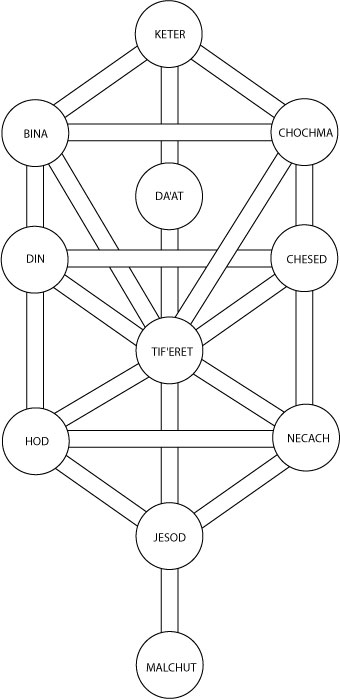
In this model, three veils beyond the tree itself represent the outer limits of existence: Ain (No-Thingness), Ain Soph (Limitlessness), and Ain Soph Air (Limitless Light).
These three veils represent God, or what I like to call cosmic soup. It is infinite potentiality, the dense, primordial singularity of all that is and all that can be. It is nothing and everything at the same time. These three states are abstractions beyond conceivability.
As nothingness contracts, it becomes denser and denser until it can no longer contain the hot, pulsing, heavy energy. It collapses, then spontaneously expands. Think Big Bang. The expansion of matter creates a container, a globe.
This container is the first of the emanations of divinity: Kether. The first spark of light immediately travels down to Chokmah, then Binah (Figure 1), like a lightning bolt.
The paths between the archetypal energy centers of emanation (Sephirot) are called the Paths of Wisdom. They represent different facets of spiritual learning, the key to unlocking divine consciousness in the material world, and vice versa.
Each Sephirot and path is a bidirectional portal, meaning that navigating either forward or backward on the path requires a harmonious blending of the two energy centers to pass through to the next level of development.
Kether’s first spark is desire, along which travels The Fool. In Kether, divine consciousness is not fully formed in gross reality. However, the Fool is its first experience of the material universe.
In this model, three veils beyond the tree itself represent the outer limits of existence: Ain (No-Thingness), Ain Soph (Limitlessness), and Ain Soph Air (Limitless Light).
These three veils represent God, or what I like to call cosmic soup. It is infinite potentiality, the dense, primordial singularity of all that is and all that can be. It is nothing and everything at the same time. These three states are abstractions beyond conceivability.
As nothingness contracts, it becomes denser and denser until it can no longer contain the hot, pulsing, heavy energy. It collapses, then spontaneously expands. Think Big Bang. The expansion of matter creates a container, a globe.
This container is the first of the emanations of divinity: Kether. The first spark of light immediately travels down to Chokmah, then Binah (Figure 1), like a lightning bolt.
Figure 1
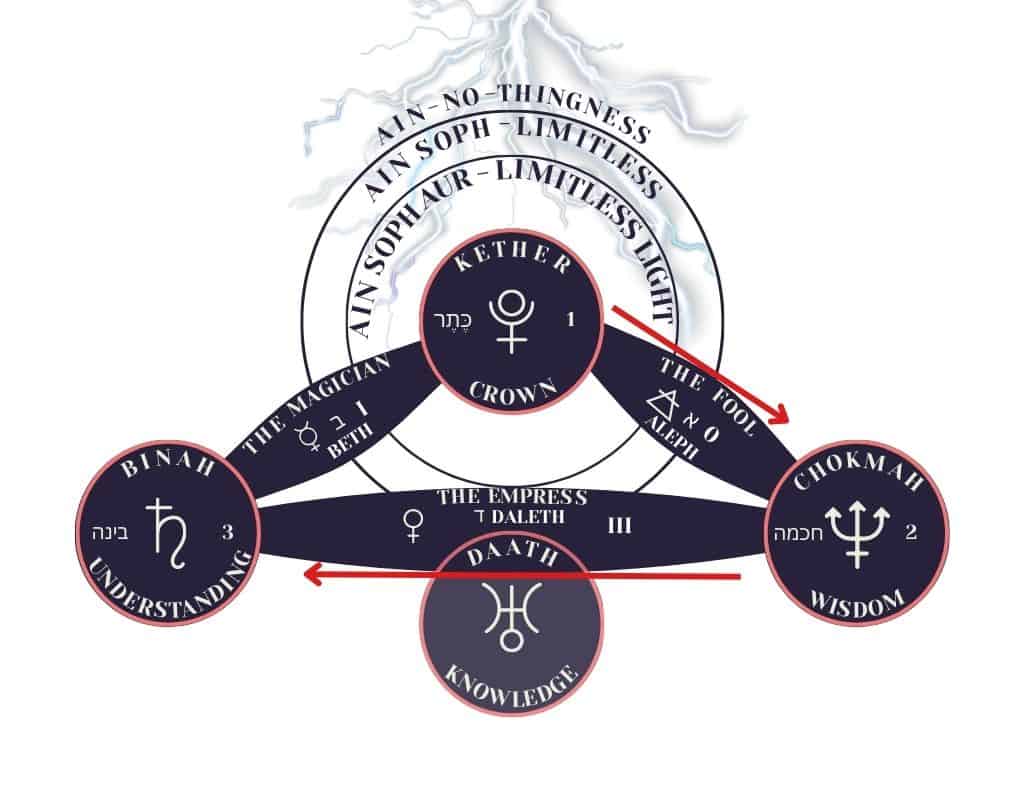
The paths between the archetypal energy centers of emanation (Sephirot) are called the Paths of Wisdom. They represent different facets of spiritual learning, the key to unlocking divine consciousness in the material world, and vice versa.
Each Sephirot and path is a bidirectional portal, meaning that navigating either forward or backward on the path requires a harmonious blending of the two energy centers to pass through to the next level of development.
Kether’s first spark is desire, along which travels The Fool. In Kether, divine consciousness is not fully formed in gross reality. However, the Fool is its first experience of the material universe.
Chokmah represents raw, primal, and dynamic force that can seem arbitrary and directionless. Like a mechanical, chaotic potentiality with no definition or constraint, but if directed and contained, it becomes shape.
The path between Kether and Chokmah symbolizes the outpouring of divine force. Chokmah can be considered the first emanation of duality represented by the archetypal father. Therefore, energy streaming from Kether to Chokmah is phallic. Energy directed forcefully and purposefully is considered phallic. The Fool, represented by the masculine air, and being thrust into existence, moves from the etheric realm in the same forceful and purposeful way.

